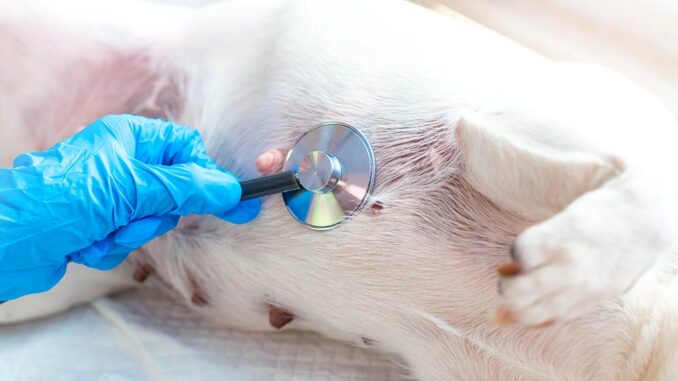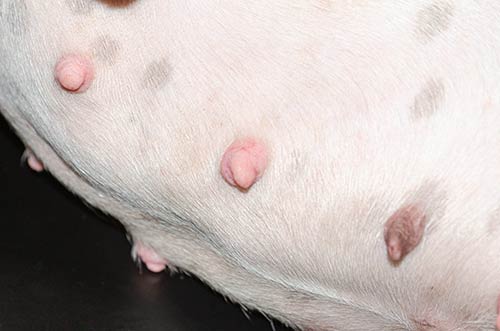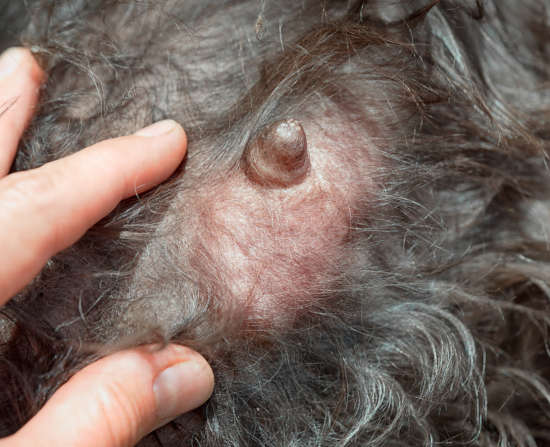
This article was updated on March 14th, 2024

If you’ve noticed one (or a few) of your dog’s nipples have suddenly turned black, it can be concerning. But there are various reasons for black nipples, and some are nothing to worry about. In this article, our veterinarians, Dr. Liz Guise & Dr. Linda Simon, discuss the possible causes of black discoloration and when the change is a cause for concern.
Key Highlights:
– It is normal for a dog to have nipples which are not all the same color
– Nipples often darken with age and can also get darker when a dog is pregnant or in heat
– Contact your vet right away if your dog seems uncomfortable or in pain: some medication conditions such as injuries, infections, or even cancer could cause a dog’s nipples to turn black
1. It’s common for dogs to have nipples of varying colors (including black)
Depending on a dog’s breed and genetics, their nipples can be a range of colors, including pink, brown, and black. Some dog breeds (like Rottweilers and Dobermans) that naturally have lots of melanin pigment can have naturally black nipples. It can be perfectly normal.
Pictured below: Notice the nipples of this healthy Jack Russel female after spaying. The bumps are low, rounded bumps with a light-pink fleshy color that blends with the skin around them (one nipple is a dark brown/black color):

Here is another example of normal black and pink nipples on a healthy Terrier female dog:

2. A female dog’s nipples can get darker when the dog is pregnant, in heat, or lactating
Nipples in pregnant and lactating dogs may also turn black due to the rise in estrogen levels:
“Both males and females have nipples, but they can be more pronounced in females, particularly if they’re in heat, pregnant, or lactating. Nipples often darken with age and we can also see that they get darker during certain times of a female’s life (such as when in season or pregnant).”
Pictured below: Nipples on a pregnant female dog. The appearance is light pink and fleshy or black, and the teats are more elongated to prepare for nursing.

3. Here are the signs that your dog’s black nipple(s) can be a problem
Unless the skin around your dog’s nipples has naturally dark pigmentation, black teats can be alarming. When nipple discoloration is caused by an injury, pregnancy, or nursing you may be able to monitor your dog at home and see if it improves. Notify your veterinarian if you see signs of pain or infection, as explained below:
“Nipple discoloration can have a variety of underlying causes, and some are concerning. Schedule an examination with your veterinarian if:
– The discoloration doesn’t resolve or grow larger
– Swollen nipples when your dog is not pregnant
– The nipple is leaking or oozing liquid
– The area has a bad odor and has a crusty appearance
– Your dog is excessively licking or scratching at the area
– Your dog has signs of infection like fever, lethargy, or loss of appetite”

4. Medical problems can also cause black nipples in dogs – here are the top causes
Besides pregnancy, there are various reasons your dog’s nipples can be black. Some are benign, while others point to health issues.
1. Hyperpigmentation
Hyperpigmentation, or darkening and thickening of the skin, can occur on nipples. The darker skin pigmentation comes from a release of melanin triggered by friction, allergies, hormonal changes, inflammation, or infection.
Tell-tale signs of hyperpigmentation include rough, thick skin with brown-black patches, hair loss, itching, and red edges around inflamed areas. Additionally, your dog may develop a secondary bacterial/yeast infection, have an odor, or seem to be in pain.
“Some cases of hyperpigmentation are merely cosmetic and will not have signs of inflammation or infections such as red edges, hair loss, odor, or pain/itching. Most other cases will resolve once your veterinarian identifies and treats the underlying cause. Treatment may include medicated shampoos, topical steroid ointments, and antimicrobials. Know that it may take several months for the skin to look normal again.”

2. Injury-related trauma
Canine nipples can become discolored and turn black with repeated irritation or injury. Possible sources of trauma or injury include:
- Irritation from puppy claws and teeth during nursing
- Rubbing the stomach across a rug or carpet (abrasions)
- Rough play with other dogs
- Reaction to contact allergies that cause inflammation and irritation
Trauma or injury to the nipples can cause the breast tissue and nipples to turn purple or black from bruising. With skin disruptions, you may also see blood, serous discharge, or scabbing. If trauma or scratching breaks the skin’s surface, your dog will be susceptible to secondary infection.
3. Inflammation or infection (mastitis)
Mastitis is an infection of the nipples/mammary glands that usually arises from bacteria. Most cases of mastitis occur in pregnant or lactating females. It is usually caused by microorganisms entering the gland or teat through abraded or injured skin surfaces.
When a dog is experiencing mastitis, they may experience swollen and painful teats, serous discharge, red or purple glands, and darkened nipples. The area may also be warm or hot to the touch. In more severe cases, your dog may be lethargic, have a fever, or lose their appetite.

4. Cancer
Certain types of cancers that can affect the nipples and mammary glands may turn the tissue black. This includes mammary gland tumors, melanomas, and squamous cell carcinomas. While cancer needs to be diagnosed by a vet, there are signs to look out for:
- Nipple discoloration or changes in size and shape
- Swollen glands or nipple discharge
- Bleeding skin lesions or crusty skin ulcerations
- Lumps or bumps in the mammary tissue or on the nipples
- Lethargy or weight loss
“Cancer requires veterinary diagnosis and care. For superficial skin cancers, the treatment is surgical removal. If the tumor is in the gland, treatment will depend on the type and stage of the cancer but may include surgical removal, radiation therapy, or chemotherapy. The prognosis varies depending on the type, location, and cancer’s stage.”

5. Inverted nipples
Inverted or recessed nipples in dogs are fairly common. When the tissue around the nipple thickens, it can pull the teat inward. Here is a good example picture of an inverted nipple. A dog with an inverted nipple may display signs like:
- swelling,
- discoloration,
- discharge, or
- red/discolored skin around the nipple.
- If lactating, your dog may experience pain or difficulty when nursing.
While inverted nipples may be benign, the condition can point to an underlying disease like cancer. That’s why inverted nipples should always be examined by a veterinarian. Additionally, leaving the condition alone can predispose your dog to mastitis or abscesses.
Treatment for inverted nipples varies depending on the cause of the inversion. Antibiotics help to clear up infections, while topical ointments or creams can be applied for trauma. Severe cases may require surgical correction.
5. What you can do at home when your dog’s nipples turn black
If you do not see any signs of pain, odor, or redness, and your dog continues to act normal with no other signs of illness, you may simply monitor the situation from home.
If you notice that your dog’s nipples suddenly turn black, you can try the following remedies (remember that home remedies are not a substitute for veterinary care, so make sure you consult with your vet first):
- Monitor the signs: Observe the area for signs of pain, odor, or redness. If your dog isn’t pregnant or nursing, look for signs of swelling. Be sure to report your observations to your veterinarian.
- Gently clean the area: Gently clean the area with a dog-safe cleanser that removes dirt and debris. The discoloration can come from dirt, so clean and inspect the area when you notice a sudden color change in your dog’s nipples.
- Warm compress: In the case of a recent injury, use a warm compress to reduce inflammation before the vet appointment. Protect injured teats by wrapping or covering them to prevent further trauma.
Frequently asked questions
Can a black nipple on my dog be a sign of cancer?
Black nipples on dogs can be a sign of certain cancers including melanoma and squamous cell carcinoma. If you notice signs of cancer listed in the “likely reasons” section above, contact your veterinarian.
My dog’s blackened nipple seems painful. Should I be worried?
When nipples turn black and become painful, it can be a symptom of infection or injury. You should take your dog to the vet for an examination and treatment. Some conditions can get steadily more severe without appropriate care.
Can spaying or neutering my dog affect nipple color?
When female dogs are spayed before their first heat or male dogs are neutered before sexual maturity, the nipples usually shrink and look more like puppy nipples. However, when females are spayed later in life, the teats may not change in shape or color.
If your dog’s nipples become discolored immediately following a spay or neuter surgery, it may indicate an infection. Other signs of post-surgical infection include fever, swelling, and nipple discharge. Immediately contact your veterinarian.
Can excessive grooming lead to blackened nipples?
Excessive grooming of the abdomen can cause irritation that may result in blackened nipples. The increased grooming behavior is likely a symptom of an underlying condition. Talk to your veterinarian about both signs.
Disclaimer: This website's content is not a substitute for veterinary care. Always consult with your veterinarian for healthcare decisions. Read More.


Be the first to comment